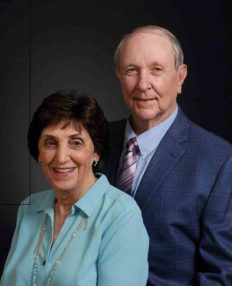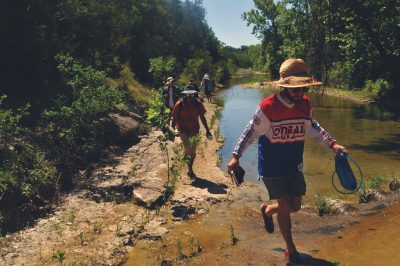White Family Outdoor Learning Center Becomes More Accessible
December 31, 2024
Donation Will Fund New Indoor Pavilion
For the past five years, Jackson School of Geosciences students have had access to 266 acres of beautiful Hill Country wilderness to use as their outdoor classroom. Concepts that are taught in presentations and labs in the Jackson School building are brought to life just an hour’s drive from campus at the White Family Outdoor Learning Center in Dripping Springs.
Complete with rocky pasture, savannah, and a section of South Onion Creek, the property is a geosciences student’s textbook come to life. Something it doesn’t have, however, is bathrooms, a water fountain, or indoor space of any kind. While geoscientists are known to spend weeks in the field, this outdoor classroom space is meant to be easily accessible to students of all levels. A complementary indoor space is crucial.

Through their generous gift of over $770,000 to the Jackson School, Jereld and Joy McQueen are making this needed addition to the White Family Outdoor Learning Center a reality. Jereld McQueen, who graduated from The University of Texas at Austin with a B.S. in Geology in 1961 and a master’s in 1963, said he has always had an affinity for field courses. In fact, he also funds a Jackson School endowment that pays for students’ field experiences.
“I’m a strong believer in geologists being out in the field, doing their work. … I believe it’s a very integral part of being a geoscientist,” he said. “This field exposure is usually restricted to those students who attend the field camp courses, but now, most of the students cycling through the Jackson School could have some opportunity to experience the field work environment.”
McQueen knew Leslie White, who passed away in 2024, and his wife, Dianne. The couple gave their ranch to the school in 2018 to become this outdoor classroom.
After McQueen graduated with his master’s degree in 1963, he moved to Corpus Christi to work for Humble Oil. There was a real camaraderie among the geologists working there, McQueen remembers. Les White was one of those geologists, and he and McQueen became friends.
While they lost touch over the years, they would cross paths every so often. McQueen also remembers learning of the Whites’ donation of their property to the Jackson School.
“When I read of Les and Dianne’s contribution, I said, wow. I was really proud of that. That was something that could be truly useful for the Jackson School — that they have all the property to do (field work) properly. So I’m hoping that (this addition) will come to fruition through time,” McQueen said.
For the 40 Hours for the Forty Acres fundraising campaign this spring, the Jackson School chose this pavilion as its priority project. Almost immediately, the McQueens agreed to provide a significant donation for the building, and the $700,000 funding requirement was met — and then exceeded — within the 40 hours.
Claudia Mora, dean of the Jackson School, said that the McQueens’ gift will enhance what is already a treasured space among geosciences students, faculty members, and researchers.
“The pavilion at the White Family Outdoor Learning Center will provide a much-needed space for students to escape the elements and synthesize what they have learned out in the field. What is already considered a special space at the Jackson School will become even more integral to our students’ learning experience,” she said.
McQueen has never been out to the property, but envisions that this new indoor facility will serve as a headquarters for its operations, paired with classroom space and storage space for sensitive instruments and equipment. Of course, it will be climate-controlled, which will be key during harsh summer days, and have bathrooms and a kitchenette.
As a master’s student studying geology, McQueen was a teaching assistant for the junior and senior field courses. He remembers doing field work at the Marathon Uplift in West Texas with the senior class. They would spend the days climbing the mountains, describing the formations, and trying not to get dehydrated. The group would then return to the ranch where they were staying and all jump in the large horse trough to cool down. That was the big event of the day, he remembers.
Much later in his life, he was on vacation in the San Juan Mountains in Colorado fishing for trout. Suddenly, a large group of geoscientists came to his fishing spot. It turns out it was a group of GEO 660 students on field camp. “Jackson School geoscientists are all over the world,” he said.

Building Students in the Field
McQueens Vision for Accessible Field Work
In the field, one gathers data which is often partially hidden or weathered — outcrops are not continuous. One must then properly describe the data. But to tell the whole story, because the earth is like one giant jigsaw puzzle, one must put the puzzle together with broken and/or missing pieces.
To put the puzzle together, the student must learn to critically think — that is, to think logically, be pragmatic, open-minded, and flexible. Additionally, the student must learn to visualize in three dimensions to see the entire story, as their data is sparse and incomplete.
The student must apply these techniques to problem solving by collecting their data, evaluating the data quality, interpreting the results, and making sensible predictions from the limited data. Only then can the student see the whole story.
If the students can acquire these techniques, they will be helpful to them for the rest of their careers, regardless of what program they decide to pursue. I firmly believe that these concepts, which I learned at the University of Texas geology school, helped me in my pursuits during my entire career.
I was strongly impacted by some of the professors at that time, such as R.E. Boyer, W. Muehlberger, W.C. Bell, and S. Clabaugh. They left a major impression on how important critical thinking and 3-D visualization were to problem solving, and they guided and trained me in the field, laboratory, and classroom.
The easily accessible White Family Outdoor Learning Center with the new facility will help the Jackson School professors to be successful in teaching the students data gathering, analyzing the data, and using critical thinking to solve the problems that confront them.
These techniques will lead to sensible and successful conclusions, and at the same time, the students will have fun and experience the satisfaction of accomplishments.
– Jereld McQueen, B.S. ’61, M.S. ’63
